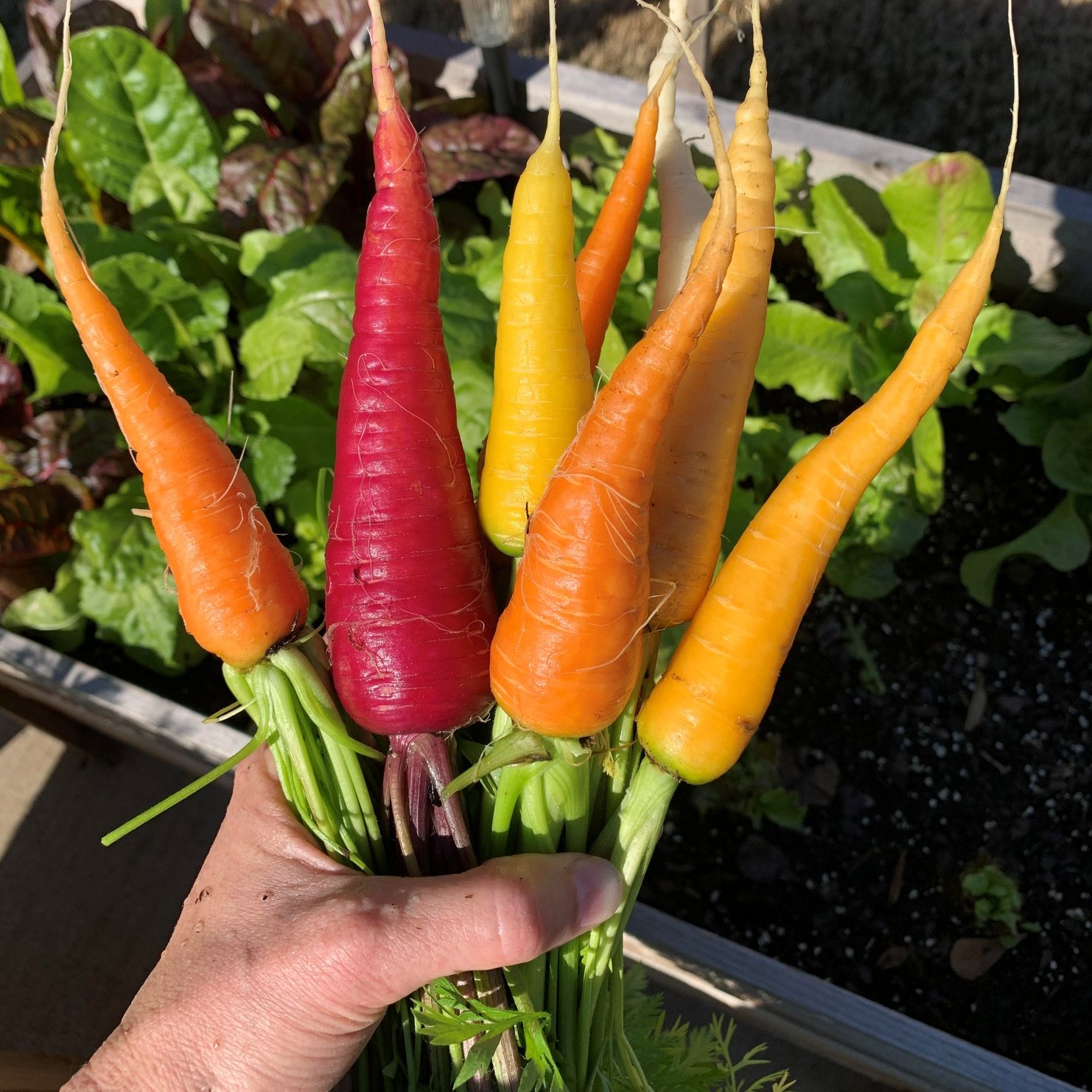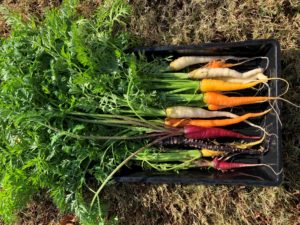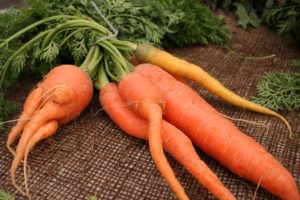Carrots are members of the Apiaceae family along with celery, dill, coriander, parsley, cumin, parsnip, and fennel. Carrots are perhaps best known for being a source of beta carotene, an antioxidant which the body converts to vitamin A. This root vegetable also has significant amounts of vitamins K and B6, as well as, potassium, and healthy soluble fiber.
Carrot History
Carrots are thought to have originated in the area of modern day Afghanistan. The Egyptians were fond of carrots as evidenced by the ones found in the tombs of pharaohs, as well as the ones depicted in hieroglyphic paintings. But carrots haven’t always been orange. Purple, black, red, white, and green carrots were all the rage in antiquity. It wasn’t until the 17th century when the Dutch cultivated an orange variety that was sweeter and less “woody” than its colorful predecessors.
This article contains affiliate links. If you make a purchase using one of these links, I will receive a very small commission at no additional cost to you, and it will help me maintain this website. Rest assured, I only recommend products I actually like!
How to Plant
Carrots, like Swiss chard, broccoli, and radishes, are a cool weather crop, meaning they do best in the fall-winter and early spring. Part of growing carrots successfully is making sure you plant them at the right time. In general, if you live in a colder climate, you’ll want to sow seeds early enough so they can be harvested before the ground freezes. In the spring, you can start sowing seeds as soon as the soil can be worked.
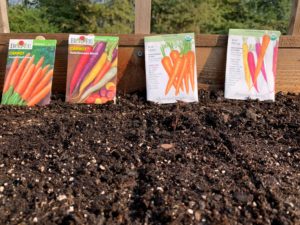
For a winter harvest in warmer climates, start seeds in the fall when the highs of summer have passed and again in the spring as soon as the soil temperature is at least 45 F (7 C), and ideally between 55 F (13 C) and 75 F (24 C). If you are unsure of the soil temperature, you can use a soil thermometer like this one. Or if you have a compost thermometer, you can use that as well, although the probe may be longer than necessary. Seedlings may bolt (begin to flower) if exposed to continuous temperatures below 50 F (10 C). You can use cold frames or row covers like the one I use to extend the season or protect the young plants from an unexpected cold snap. Whether you live in a colder or warmer climate, it is best to consult the seed packet for more specific information.
Because carrots are a root crop, it is best to direct sow the seed instead of doing transplants, which can cause the roots to be deformed. Carrot seeds are very small and there are a variety of methods for planting them. Some like to sprinkle the seeds down a row and lightly cover them with soil. If that is you, the rows need to be spaced 12 to 15 inches apart, depending on the variety. Others prefer sowing individual seeds to avoid thinning seedlings later on. It can be a bit more tedious but those who prefer this method say it is worth it. You can also purchase pelleted seeds which are seeds that have been coated with a biodegradable material to make them larger and easier to handle. The coating is said to protect the seed from drying out and reportedly will not affect germination.
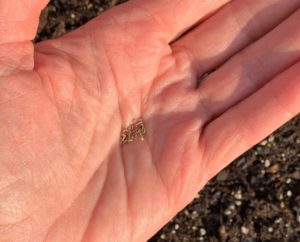
Water the seeds using a gentle spray so as not to dislodge them. Keep the soil moist and the seeds will germinate in about 8 to 25 days. Some gardeners like to lay a board across the seeds to promote germination. The board or other similar object traps moisture and prevents the wind or birds from disturbing the seeds. Be sure to check every few days. Once the seeds germinate, remove the board. Note that the colder the soil the longer it will take the seeds to germinate. Once the seedlings have reached 1.5 to 2 inches tall, thin them to one every 3 inches by cutting the unwanted seedlings off at the soil level instead of pulling them up as this may disturb the neighboring seedling.
Sun, Soil, Water, and Fertilizer
Carrots need at least six hours of full sun. Some varieties may be able to tolerate some shade during the spring as the temperatures begin to heat up, but as a general rule, they will need to get plenty of sunlight.
Planting in the right soil is one of the keys to having a successful harvest. The soil needs to be loose, well-draining, and free from rocks, sticks, clumps, and other debris, to a depth of about 12 inches. Carrots will not grow in soil that contains a high percentage of clay because the root will be unable to penetrate the soil and will result in stunted or deformed carrots. If you have a minimal amount of clay, however, you may be able to improve it by adding fully composted organic matter. For this reason, many opt to plant carrots in raised beds and containers so the soil can be easily managed. I have grown carrots in containers and raised planter boxes with great success so you may want to consider this an option, especially if you have struggled to grow them in traditional beds in the past. You can learn how to build your own by reading How to Build A Planter Box Using Cedar Fence Pickets.
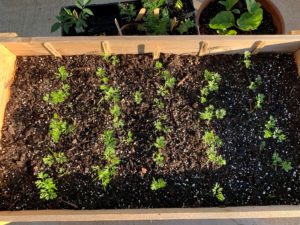
If you decide to grow carrots in a container, you will need to select a container that drains well. The depth of the container is more important than the diameter as it will determine what varieties you can grow. For example, I am currently growing carrots in containers that are 10, 12, and 14 inches deep so I chose varieties that grow between 7 and 10 inches long. As for seed spacing, be sure to follow the recommendations on the seed packet, but in general, you should be able to sow about 10-12 seeds in a pot that is 12 inches in diameter. You may also need to water more frequently as the soil tends to dry out quicker in a container. You can learn more about starting a container garden in my article, How to Start a Container Garden.
The soil, whether it is in a traditional bed or a container, needs to have a pH between 5.5 to 7.0. If you are unsure of your soil’s pH, you can find out by using a simple soil test kit like the one I have. It’s easy to do and takes just a few minutes.
Supplying the right amount of water is also important for well-formed carrots. The soil should not be allowed to dry out, nor should it be soggy as overwatering can cause problems as well. Consistency in watering is also important. If the soil moisture fluctuates too much it can cause the carrots to crack. Adding a layer of mulch can help the soil retain moisture.
Carrots, like beets and other root crops, need phosphorus to properly develop. If you plant in rich, healthy soil, you should not have to fertilize them. If on the other hand, you do a soil test and find that phosphorus or potassium are deficient, you will need to amend the soil with bone meal (phosphorus) or green sand (potassium). Carefully follow package directions as more is not better. All plants, including root crops, need nitrogen but do not add additional nitrogen to the soil as this nutrient will cause the leafy tops to grow but not the root (carrot). Excess nitrogen can also cause carrots to be covered in small root hairs which will change their texture and taste. Too much nitrogen can also cause carrots to fork.
If the carrots begin to crown, that is, if you can see the top of the carrot peeking out of the soil, you will want to recover it with soil. Otherwise, the carrot may turn green and become bitter.
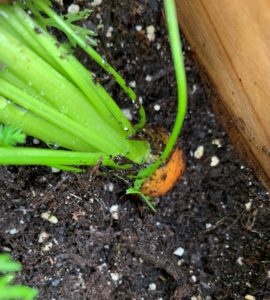
Weeds compete with carrots for soil nutrients so be sure to keep weeds under control. Be careful, though, when weeding so that you do not inadvertently disturb the carrots. Another advantage to growing in containers is that you do not have to deal with weeds.
Pests and Diseases
Carrot Weevils – The adult weevils are a mere 1/5 inch long, brown, and have a snout, while the larvae look like white or cream grubs with a brown head. Spring crops are especially susceptible to carrot weevils. The adults feed on the leaves while the larvae tunnel into the carrot roots. Neem oil is said to be effective on older larvae. You can also practice crop rotation to avoid them.
Carrot Rust Flies – One of the main pests you will need to keep an eye out for, especially in the spring, is the carrot rust fly. This small, green fly looks similar to a housefly except it has a yellow head and red eyes. Carrot rust flies will lay their eggs in the soil close to the carrot. Once the eggs hatch, the white or cream larvae will dig into the soil and feed on the carrot, making tunnels in the root in the process. The leaves will turn black and the carrot will turn dark. The best way to deal with this pest is to use row covers.
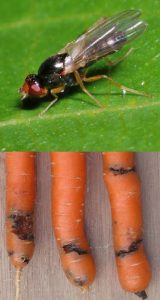
Nematodes – Nematodes are worm-like microscopic parasites that feed on roots. They enter through the tip of the carrot causing it to fork and develop galls, which are areas of tumor-like swelling. Often a nematode issue isn’t discovered until the carrots are harvested. Do not plant carrots in areas where there is a known nematode problem as carrots are more susceptible than other crops. You can learn more about this harmful parasite and how to eliminate it in this helpful article.
Leafhoppers – Aster leafhoppers are spotted, pale green, wedge-shaped insects that measure about a 1/2 inch. True to their name, they hop and then fly away when disturbed. While these pests are sapsuckers, the real threat to carrots is because they are carriers for aster yellow disease which causes stunted carrots with discolored greens and hairy roots. To control leafhoppers remove weeds where they can hide and overwinter and install row covers to block their access to the plants. You can also apply food grade diatomaceous earth (DE) which is the powdered remains of fossilized organisms whose micro-sharp edges scrape insects that come into contact with the powder. Sprinkle it on the plant surfaces and soil. You will have to reapply if it rains or the plant gets wet. Take care to protect your eyes, and do not inhale the powder as it can be potentially harmful. Insecticidal soap is also a good option (see below: flea beetles).

Flea Beetles – Flea beetles are small black beetles (they can also be brown, bronze, metallic gray, or iridescent blue, etc.) that eat small holes in the leaves of plants, while the larvae feed on the roots. You know they are flea beetles because they will jump like a flea when they are disturbed. Food grade diatomaceous earth (DE) is a good remedy for these small beetles. You can also apply an insecticidal soap that is easy to make and cost-effective. Learn more about how to get rid of this garden pest organically in my article Flea Beetles: How to Identify and Treat Organically.
Alternatively, you can mix 2 cups of rubbing alcohol with 5 cups of water and 1 tablespoon of a chemical-free soap like Dr. Bonner’s or Dr. Wood’s. Be sure to do a test spray first and wait 24-48 hours to see if the leaf is damaged. If so, dilute the mixture more and repeat the test. Once it passes the test, spray the plant, including under the leaves. Row covers are also an effective way to protect your carrots from flea beetles.
Leaf Blight – The two primary types of leaf blight that can infect carrots are Alternaria blight and Cercospora blight. The former is characterized by brown and black legions with yellow edges on leaf margins, starting on the oldest leaves, while the latter is characterized by small dark spots with yellow margins beginning on younger leaves and stems. To reduce the occurrence of either blight, water the plants at soil level and allow for proper spacing between plants. Also, avoid applying excessive nitrogen which promotes leaf growth and restricts airflow between plants. You can also choose varieties that are blight resistant.
Harvest
Most carrot varieties take between 65 and 80 days to reach maturity. The seed package should provide you with a specific time frame for that variety. If you can wait to harvest until there has been one or more frosts, the plants will start to store sugars in their roots, making the carrots taste sweeter.
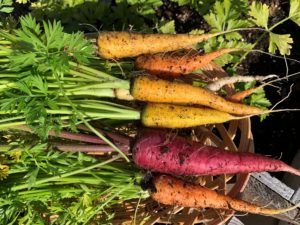
Before harvesting, lightly water the bed or container to help the carrots come out easier. You should be able to gently twist and pull the carrot from the soil. If not, use a hand trowel to carefully dig the carrot out, making sure not to damage it in the process. Carrots ready for harvest in the fall-winter can temporarily remain in the ground as long as the ground doesn’t freeze. If temperatures drop, you may need to cover them with straw, dry leaves, or a row cover. For spring carrots, don’t leave them in the soil too long because when the soil heats up it can cause them to turn fibrous.
To store your harvest in the refrigerator, remove the green tops, leaving a half-inch “stem.” Remove the excess dirt and, if you prefer, rinse them off and pat them dry. Seal them in plastic storage bags or in a glass container to keep the air out. For longer term storage, remove all but a 1/2 inch of the green tops and any excess dirt, but do not wash them. Layer them in a tub of moist sand or peat moss so that they are not touching, and top them with dry straw. Place the tub in a dry, cool location like a root cellar. They should last for at least a few months.
If you are interested in saving carrot seeds, you will have to wait until the second year because they, like broccoli, are biennial and will not produce seed the first year.
Varieties
There are so many varieties of carrots to choose from. Short, long, tapered end, blunt end, thin, thick, orange and a host of other colors. The important thing to remember when deciding which variety to grow is the size of the root and the days to maturity. You may also want to consider certain resistant varieties if you have experienced pest or disease issues in previous seasons. Here are some popular varieties:
Danvers 126 are orange heirloom carrots that work well in heavier soil because they are resistant to cracking. They are also frost tolerant. The 6 to 7 inch carrots are ready to harvest in about 65 days.
Nantes Half Longs are slender, almost coreless orange carrots that grow to about 6 or 7 inches long. They mature in about 65 to 70 days.
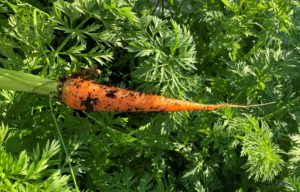
Chantenay is an orange carrot variety that grows to about 8 inches long and is ready in about 75 days.
Tendersweet is an orange-red heirloom variety that grows to about 10 inches in length. They are said to be sweet and thus true to their name. They mature in 75 days.
Carnival Blend offers a colorful array of carrots including orange, yellow, red, purple, and white. They grow to a length of about 8 to 10 inches, are frost tolerant, and ready to be harvested in 65 to 75 days.
Kaleidoscope Blend or Rainbow Carrots is another colorful option that includes five different varieties: Atomic Red, Bambino Orange, Cosmic Purple, Lunar White, and Solar Yellow. They grow to be about 8 inches long and are ready in 75 to 80 days.
Little Fingers are small, about 3″ long, but sweet orange carrots that mature in only 55 days.
Baby Carrots – Some mistakenly believe that baby carrots like the ones you can purchase from the store are small, immature carrots. But immature carrots are tasteless. In reality, the miniature carrots are mature carrots that have been shaved down to the core where it is sweeter. If you want to grow carrots that are small, though mature, consider planting Little Fingers or one of the other short carrot varieties.
Homegrown carrots taste so much better than store-bought ones. With a little planning and attention to detail, you can grow this amazing vegetable in your own backyard!
Thank you for reading this article! If you found it helpful, please consider sharing it with others on social media!
